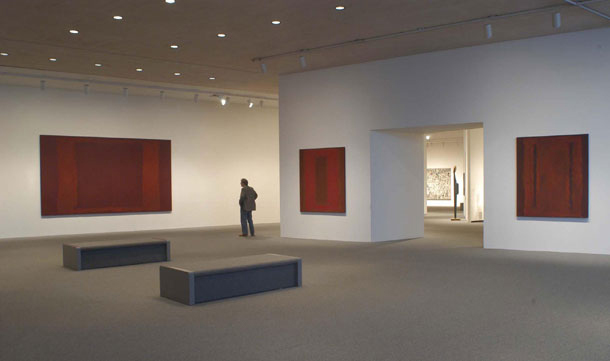Mark Rothko: The Mural Projects

This installation of Mark Rothko's mural paintings celebrates the centenary of the artist's birth. Rothko (1903 - 1970) was a central figure of the New York School--a circle of abstract expressionist painters that emerged in the post-World War II era--and is best known for his luminous paintings of the early 1950s. The murals, which reflect a dramatic darkening of the artist's palette, also represent a significant shift in his approach to composition. The paintings on view here (all but one of which were given to the National Gallery by The Mark Rothko Foundation) include panels, alternates, and large-scale "sketches" on canvas executed for two mural commissions: a 1958 -1959 project for Mies van der Rohe and Philip Johnson's Seagram Building in New York City, and a 1961-1962 commission for Harvard University.
Installation of Mark Rothko's Mural Commissions, Photo: Rob Shelley, National Gallery of Art
(left) Untitled (Seagram Mural), 1959, oil on canvas, Gift of The Mark Rothko Foundation, Inc. Copyright © 1997 Christopher Rothko and Kate Rothko Prizel, 1986.43.167
(middle) Untitled (Seagram Mural sketch), 1959, oil and acrylic on canvas, Gift of The Mark Rothko Foundation, Inc. Copyright © 1997 Christopher Rothko and Kate Rothko Prizel, 1985.38.3
(right) Untitled (Seagram Mural sketch), 1958, oil and acrylic on canvas, Gift of The Mark Rothko Foundation, Inc. Copyright © 1997 Christopher Rothko and Kate Rothko Prizel, 1985.38.1

For the Seagram commission, Rothko created three groups of prospective works, using varying combinations of deep maroons, brilliant reds, rich browns, and blacks. No. 9 (White and Black on Wine) was among the first works created in relation to the project, and it retains Rothko's classic motif of hovering, soft-edged rectangular forms. In subsequent Seagram paintings, the artist changed his approach: rotating the horizontal forms, he created vertical, framelike shapes. Rothko also produced long horizontal panels, which were unusual for him but well-suited to the intended spaces and to the principle of mural painting. The Harvard murals employ a similar format and range of color, as can be seen in the painterly "sketch" in this installation.
For both mural campaigns Rothko produced expansive and darkly luminous canvases, each with related yet subtly shifting forms, in an attempt to create an all-encompassing environment. The artist clearly hoped the works would elicit an intensely emotional response, inspiring a meditative experience on the part of the viewer. On at least one occasion, he described his Harvard murals in the context of the Passion and Resurrection of Christ. The power of these somber works derives from Rothko's new compositional motif, which resembles a portal or window. This form invites the gaze, yet the viewer is kept at a perpetual threshold by the resistance of the dark ground. Both mural projects, therefore, are exercises in the creation of a closed space, something hinted at in Rothko's comparison of the Seagram murals to Michelangelo's Laurentian Library in Florence, in which windows exist but are forever sealed. The artist further underscored the architectural nature of the murals, remarking that the panels "are not paintings"; instead he proclaimed, "I have made a place."
Installation of Mark Rothko's Mural Commissions, Photo: Rob Shelley, National Gallery of Art
(left) Untitled (Seagram Mural), 1959, oil and mixed media on canvas, Gift of The Mark Rothko Foundation, Inc. Copyright © 1997 Christopher Rothko and Kate Rothko Prizel, 1985.38.5
(right) Untitled (Seagram Mural sketch), 1958, oil on canvas, Gift of The Mark Rothko Foundation, Inc. Copyright © 1997 Christopher Rothko and Kate Rothko Prizel, 1986.43.170

In 1952, Rothko stated that he had "a deep sense of responsibility for the life my pictures will lead out in the world." Accordingly, the artist attempted to influence the circumstances under which his work was viewed, often expressing strong preferences for wall color, hanging height, and lighting. The Seagram and Harvard mural commissions, which enabled him to create work for controlled architectural environments, were of profound importance to the artist. Unfortunately, neither series of panels can be seen as it was originally conceived. Rothko ultimately withdrew from the Seagram Building commission, believing that an extravagant dining room was an inappropriate environment for the placement of his work. The six Harvard mural panels were completed in 1962 and installed in 1964 in the university's Holyoke Center. Their appearance was significantly altered through exposure to light, however, prompting their eventual removal in 1979. While neither setting can be duplicated here, by exhibiting multiple panels produced for these commissions, we can approximate Rothko's ambition to create unified interiors--an enduring aspect of his legacy.
Installation of Mark Rothko's Mural Commissions, Photo: Rob Shelley, National Gallery of Art
(left) Untitled (Seagram Mural), 1959, oil on canvas, Gift of The Mark Rothko Foundation, Inc. Copyright © 1997 Christopher Rothko and Kate Rothko Prizel, 1986.43.167
(right) Untitled (Harvard Mural sketch), 1962, oil and mixed media on canvas, Gift of The Mark Rothko Foundation, Inc. Copyright © 1997 Christopher Rothko and Kate Rothko Prizel, 1986.43.169
(middle) Untitled (Seagram Mural sketch), 1958, oil and acrylic on canvas, Gift of The Mark Rothko Foundation, Inc. Copyright © 1997 Christopher Rothko and Kate Rothko Prizel, 1985.38.1